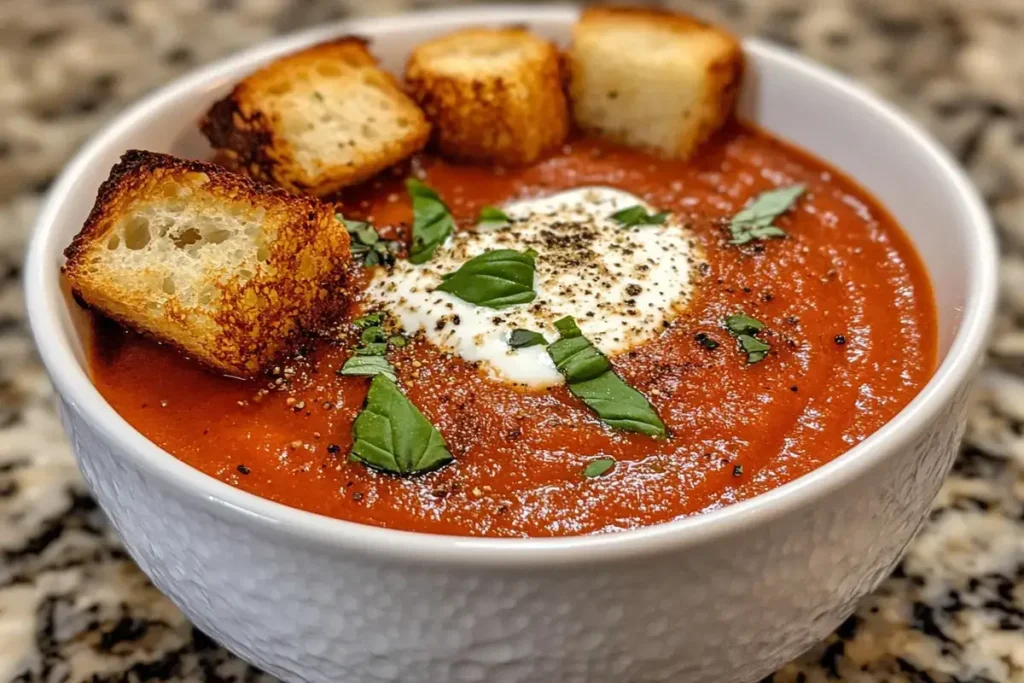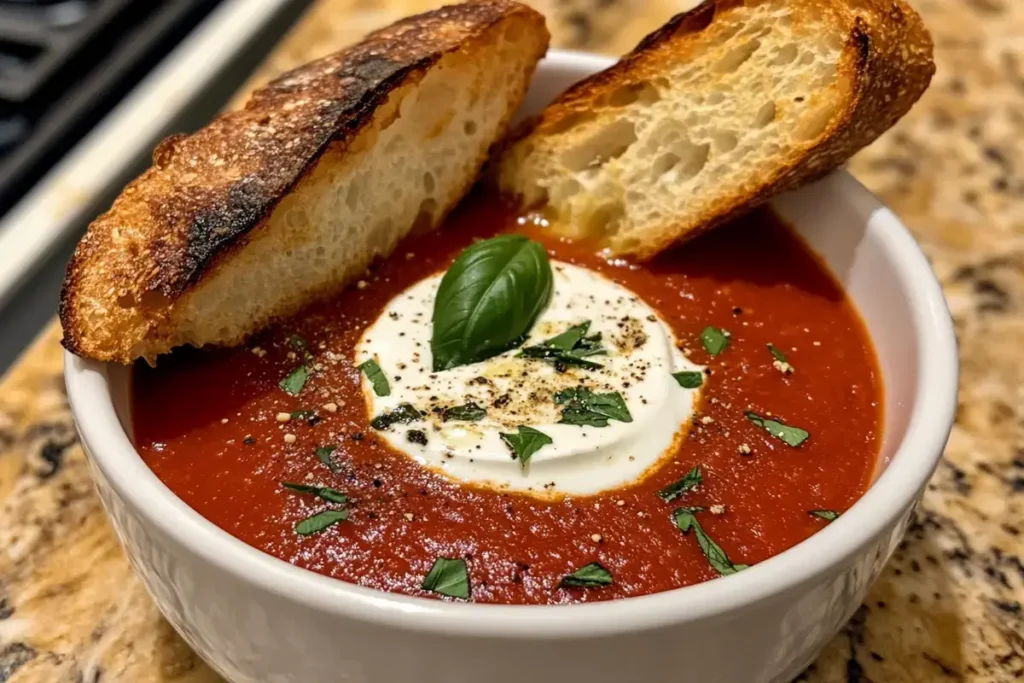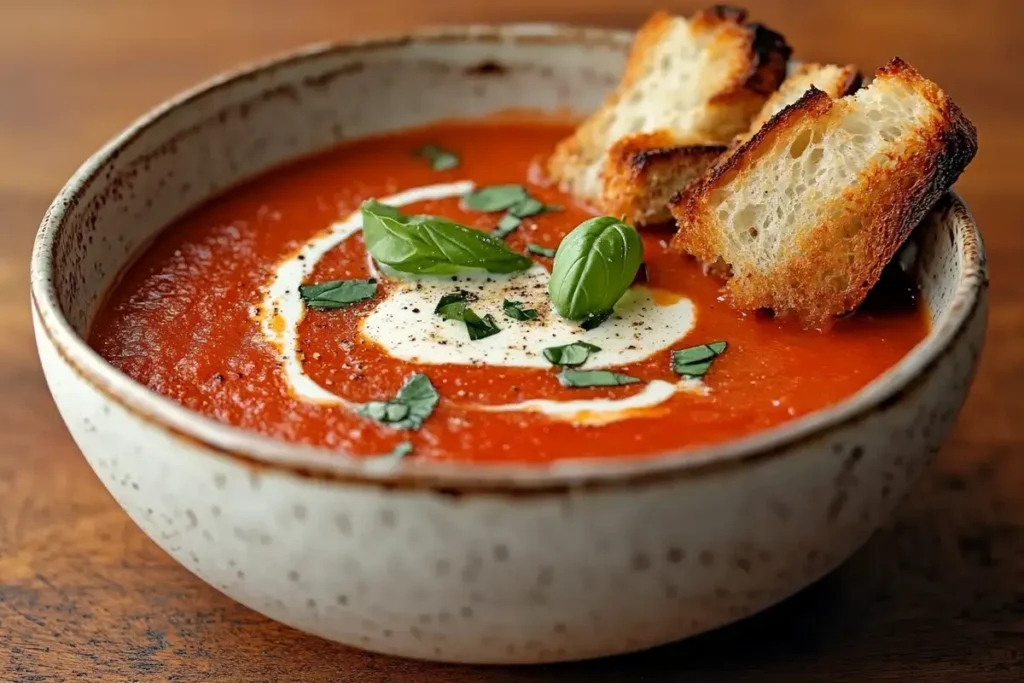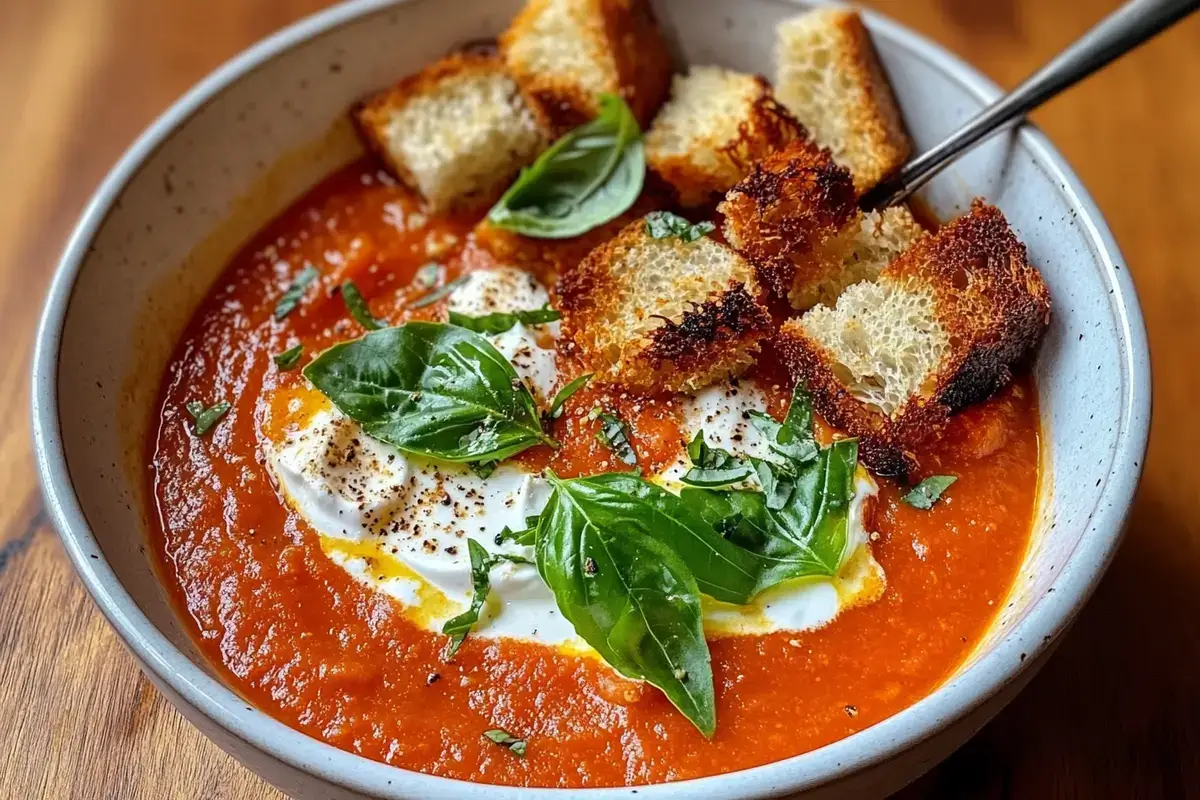A roasted tomato soup recipe offers a depth of flavor that transforms a simple classic into an extraordinary culinary experience. Roasting the tomatoes, along with other aromatic vegetables, caramelizes their natural sugars and intensifies their taste, creating a soup that is both comforting and complex. This method elevates the humble tomato soup from a pantry staple to a gourmet delight, perfect for a cozy evening or an impressive starter. Making this soup from scratch is surprisingly straightforward, yielding results far superior to any canned variety. Furthermore, crafting your own roasted tomato soup recipe allows for customization, letting you tailor the richness, spice, and texture to your exact preference.
Why Choose a Roasted Tomato Soup Recipe?
Opting for a roasted tomato soup recipe over a standard one brings several distinct advantages. The roasting process is key; it fundamentally changes the character of the tomatoes and other ingredients, resulting in a soup with unparalleled depth and richness. It’s a simple technique with a significant impact on the final dish.
Moreover, this approach often requires less hands-on cooking time compared to simmering raw tomatoes for extended periods. While the oven does its work, you are free to attend to other tasks. This makes a seemingly sophisticated roasted tomato soup recipe quite manageable, even on a busier day.
The Magic of Roasting Tomatoes:
Roasting tomatoes under high heat works wonders. The dry heat draws out moisture, concentrating the tomato flavor intensely. Simultaneously, the natural sugars caramelize, adding layers of sweetness and complexity that you simply cannot achieve by boiling or simmering alone.
This process also imparts a subtle smoky char, especially if you allow the edges to brown slightly. This smokiness adds another dimension to the soup’s profile. Therefore, the roasting step is not merely preparation; it is the core technique that defines this type of tomato soup.
Depth of Flavor You Can’t Get Otherwise:
The concentrated, caramelized flavors developed during roasting permeate the entire soup. When blended, these roasted tomatoes, along with garlic, onions, and herbs that often accompany them in the roasting pan, create a synergy of tastes. The result is a robust, full-bodied soup.
Compared to soups made with raw or canned tomatoes simmered directly, a roasted tomato soup recipe delivers a noticeably richer, slightly sweeter, and more complex flavor profile. It tastes less acidic and more well-rounded, offering a truly satisfying experience for the palate.
Simplicity Meets Elegance:
Despite the gourmet flavor profile, preparing a roasted tomato soup recipe is remarkably simple. The bulk of the effort involves roughly chopping vegetables, tossing them with oil and seasonings, and letting the oven handle the cooking. This minimal hands-on time makes it an accessible recipe for cooks of all levels.
The elegance comes from the final product – a vibrant, deeply flavorful soup that feels special. It’s the kind of dish that impresses guests or makes a simple weeknight meal feel a little more luxurious, all achieved through a straightforward roasting technique.

Essential Ingredients for the Perfect Roasted Tomato Soup Recipe
Gathering high-quality ingredients is the first step toward a truly delicious roasted tomato soup recipe. While the technique is crucial, the raw materials form the foundation of the flavor. Freshness and suitability for roasting are key considerations.
Selecting the Right Tomatoes:
The star of the show, tomatoes, should be chosen carefully. Ripe, flavorful tomatoes are essential. Varieties like Roma or plum tomatoes are often preferred because they have lower water content and fewer seeds, leading to a thicker, richer soup after roasting. However, good quality vine-ripened or heirloom tomatoes also work beautifully, contributing their unique flavor profiles. Using a mix can sometimes add complexity. The most important factor is ripeness – look for deep color and a firm yet yielding texture.
Aromatic Vegetables: Onion and Garlic:
Onion and garlic are fundamental aromatics that build the soup’s flavor base. Roasting mellows their sharpness, bringing out a sweet, savory character that complements the tomatoes perfectly. Yellow or sweet onions work well. Several cloves of garlic, roasted whole or roughly chopped within their skins (to prevent burning), become creamy and sweet, adding significant depth. Don’t skimp on these essentials; their roasted transformation is vital to the overall taste of your roasted tomato soup recipe.
Herbs and Seasonings:
Fresh or dried herbs enhance the soup’s aroma and taste. Thyme, rosemary, oregano, and basil are classic choices that pair wonderfully with tomatoes. You can add sprigs of fresh herbs to the roasting pan or use dried herbs tossed with the vegetables before roasting. Salt and freshly ground black pepper are non-negotiable for seasoning the vegetables during roasting and adjusting the final soup. A pinch of sugar can sometimes balance the acidity, especially if the tomatoes aren’t perfectly ripe.
Olive Oil: The Roasting Medium:
Good quality olive oil is necessary for roasting. It coats the vegetables, facilitating heat transfer, preventing sticking, and adding its own fruity flavor notes. Extra virgin olive oil offers the best flavor, but a regular olive oil also works fine for roasting. Ensure the vegetables are adequately coated, but not swimming in oil, for optimal caramelization.
Broth: Vegetable or Chicken?
Vegetable broth keeps the soup vegetarian or vegan (if no cream is used). Chicken broth adds a slightly richer, deeper savory note. The choice depends on dietary preferences and the desired flavor profile. Use a low-sodium broth to better control the final saltiness of the soup. The broth is used to thin the blended roasted vegetables to the desired soup consistency.
Optional Creaminess: Cream, Coconut Milk, or Cashews
For a richer, creamier texture, you have several options. Heavy cream adds classic richness. Full-fat coconut milk provides creaminess with a subtle tropical note, making it a great vegan alternative. Soaked and blended cashews can also create a surprisingly creamy, dairy-free soup base. Adding creaminess is optional; the roasted tomato soup recipe is delicious even without it, showcasing a purer roasted vegetable flavor.
Step-by-Step Guide to Making Roasted Tomato Soup
Following a clear process ensures success when making your roasted tomato soup recipe. From preparation to serving, each step contributes to the final delicious result. This guide breaks down the process into manageable stages.
Preparation: Getting Your Ingredients Ready
Begin by preheating your oven to a relatively high temperature, typically around 400°F (200°C). While the oven heats, prepare your vegetables. Wash the tomatoes and halve or quarter them depending on size. Peel and roughly chop the onion. Peel the garlic cloves, or leave them in their skins if roasting whole.
Place the prepared tomatoes, onion, and garlic onto a large baking sheet, preferably lined with parchment paper for easier cleanup. Drizzle generously with olive oil, ensuring everything is lightly coated. Sprinkle with your chosen herbs (fresh sprigs or dried), salt, and pepper. Toss gently to combine. Spread the vegetables in a single layer to ensure even roasting.
The Roasting Process: Achieving Caramelization
Place the baking sheet into the preheated oven. Roast for approximately 30-45 minutes. The exact time depends on your oven and the size of the vegetable pieces. You’re looking for the tomatoes to soften, collapse slightly, and develop some caramelized brown spots around the edges. The onions should be soft and slightly browned, and the garlic should be tender and fragrant.
Keep an eye on the vegetables during the last 10-15 minutes to prevent excessive charring or burning, especially the garlic if peeled. Properly roasted vegetables are the heart of a great roasted tomato soup recipe.
Blending: Creating a Smooth Texture
Once the vegetables are perfectly roasted, remove the baking sheet from the oven and let them cool slightly for a few minutes. This makes handling them safer. If you roasted garlic in its skin, squeeze the softened cloves out. Discard any large herb stems (like rosemary or thyme) if used.
Transfer the roasted vegetables and any accumulated juices from the baking sheet into a high-powered blender. If your blender is small, you may need to do this in batches. Add a small amount of broth (about 1/2 to 1 cup) to help the blending process start smoothly. Blend until the mixture is very smooth. For an ultra-smooth texture, you can strain the soup through a fine-mesh sieve, but this is optional and removes some of the beneficial fiber.
Simmering and Finishing Touches
Pour the blended soup mixture into a large pot or Dutch oven. Stir in the remaining broth, adding gradually until you reach your desired consistency. Some prefer a thicker soup, while others like it thinner. Bring the soup to a gentle simmer over medium heat. Avoid boiling it vigorously.
Taste the soup and adjust seasonings as needed. Add more salt, pepper, or even a pinch of sugar if required. If you’re adding cream, coconut milk, or blended cashews for extra richness, stir it in during this final simmering stage. Let the soup simmer gently for about 10-15 minutes to allow the flavors to meld together perfectly. Your delicious roasted tomato soup recipe is now ready to serve.

Tips and Variations for Your Roasted Tomato Soup Recipe
Once you’ve mastered the basic roasted tomato soup recipe, there are numerous ways to customize it. These tips and variations can add new dimensions of flavor or cater to specific dietary needs or preferences. Experimentation is part of the fun in home cooking.
Adding Spice: Chilli Flakes or Cayenne
For those who enjoy a bit of heat, incorporating spice is easy. Add a pinch of red pepper flakes (chilli flakes) or a dash of cayenne pepper along with the other seasonings before roasting the vegetables. Alternatively, stir it into the soup during the final simmering stage. Start with a small amount and add more to taste, as the heat can intensify as the soup sits.
Incorporating Other Roasted Vegetables:
Don’t limit yourself to just tomatoes, onions, and garlic. Roasting other vegetables alongside them can add unique flavors and nutritional value. Red bell peppers become wonderfully sweet when roasted and complement tomatoes beautifully. Carrots add extra sweetness and body. Even vegetables like zucchini or fennel can be included for interesting variations on the classic roasted tomato soup recipe.
Garnishes That Elevate:
Garnishes add visual appeal and textural contrast. Classic options include a swirl of heavy cream or olive oil, a sprinkle of fresh chopped basil or parsley, or homemade croutons. Toasted pumpkin seeds (pepitas), a dollop of pesto, crumbled feta or goat cheese, or even a spoonful of crème fraîche can transform a simple bowl into something special.
Storage and Reheating Instructions:
Roasted tomato soup stores well, and its flavor often deepens overnight. Allow the soup to cool completely before transferring it to an airtight container. It can be refrigerated for up to 4-5 days. For longer storage, freeze the soup in freezer-safe containers or bags for up to 3 months. Thaw frozen soup in the refrigerator overnight before reheating. Reheat gently on the stovetop over medium-low heat, stirring occasionally, until heated through. Avoid boiling, especially if cream has been added, as it can cause separation. You might need to add a splash of broth or water if the soup has thickened upon storage.
Serving Suggestions: Beyond the Bowl
While a simple bowl of roasted tomato soup is delightful on its own, pairing it correctly or enhancing it further can create a more complete and satisfying meal. Consider these serving suggestions to make the most of your homemade roasted tomato soup recipe.
Classic Pairings: Grilled Cheese Sandwiches
The quintessential pairing for tomato soup is a gooey, buttery grilled cheese sandwich. The richness of the cheese and the crispiness of the bread provide a perfect counterpoint to the tangy, savory soup. Dunking the sandwich into the soup is a time-honored tradition for many. Use different types of bread and cheese combinations to keep this classic pairing interesting. Sourdough with sharp cheddar or multigrain with provolone are excellent choices.
Creative Toppings: Croutons, Pesto, Fresh Herbs
Beyond basic garnishes, creative toppings can add layers of flavor and texture. Homemade croutons, seasoned with garlic and herbs, offer a satisfying crunch. A swirl of vibrant green pesto adds a fresh, herbaceous kick. Freshly chopped herbs like chives, dill, or cilantro (coriander) can provide brightness. A dollop of sour cream or Greek yogurt can add a cool tanginess. Experiment with these to find your favorite combinations for your roasted tomato soup recipe.
Making it a Meal: Adding Protein or Grains
To turn your roasted tomato soup into a more substantial meal, consider adding protein or grains. Stir in cooked shredded chicken, white beans (like cannellini or navy beans), or lentils for added protein and fiber. Cooked grains such as quinoa, farro, or orzo can also be mixed in to make the soup heartier. Serving the soup alongside a fresh green salad or crusty bread also helps create a balanced and filling meal. These additions make the versatile roasted tomato soup recipe suitable for lunch or a light dinner.

FAQs
What can you add to tomato soup to make it better?
To enhance tomato soup, consider adding roasted garlic for depth, a swirl of pesto for herbaceousness, or heavy cream/coconut milk for richness. Smoked paprika offers smokiness, while a pinch of red pepper flakes adds heat. Fresh basil, croutons, or a dollop of sour cream also elevate the flavor and texture. Roasting the tomatoes themselves, as in this roasted tomato soup recipe, is arguably the best way to improve flavor.
What is the difference between tomato soup and tomato shorba?
Tomato soup, particularly in Western cuisine, is typically smoother, often creamier, and milder in flavor, sometimes with a focus on the pure tomato taste. Tomato shorba, originating from the Indian subcontinent, is generally thinner in consistency, often broth-based, and characterized by the addition of aromatic spices like cumin, coriander, ginger, and sometimes turmeric or chilli. Shorba often has a more complex, spiced flavor profile compared to standard tomato soup.
What are the ingredients in Knorr tomato soup with croutons?
Commercial soup mixes like Knorr’s typically contain dehydrated tomato powder, starch (like corn starch or potato starch) for thickening, sugar, salt, maltodextrin, flavor enhancers (like MSG), vegetable oils, dried vegetables (onion, garlic), spices, acidity regulators, and dehydrated croutons (made from wheat flour, oil, salt, yeast). Ingredients can vary slightly by region and specific product version. Making a homemade roasted tomato soup recipe avoids many of these processed components.
Is tomato soup good for fatty liver?
Tomato soup, especially homemade versions like a roasted tomato soup recipe made with fresh ingredients and minimal added fat or sugar, can be part of a healthy diet beneficial for managing fatty liver disease. Tomatoes are rich in lycopene, an antioxidant with potential liver-protective effects. However, canned or highly processed tomato soups can be high in sodium and sugar, which are detrimental. A low-fat, low-sugar homemade soup emphasizing fresh tomatoes and vegetables is a better choice. Always consult a healthcare provider for personalized dietary advice regarding fatty liver.

